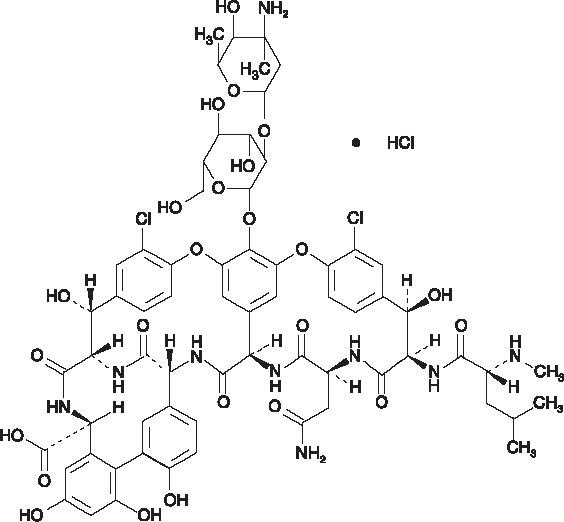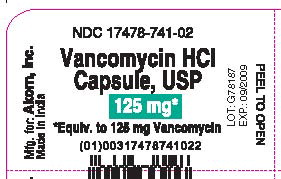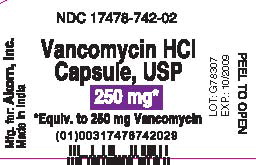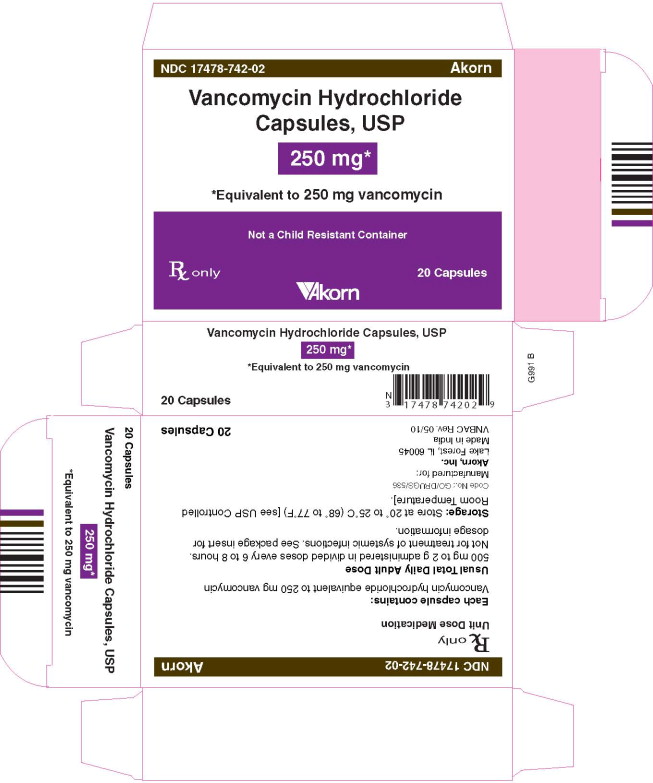VANCOMYCIN HYDROCHLORIDE
-
vancomycin hydrochloride capsule
Akorn, Inc.
----------
VANCOMYCIN HYDROCHLORIDECAPSULES, USP
Rx only
To reduce the development of drug-resistant bacteria and maintain the effectiveness of Vancomycin HCl Capsules and other antibacterial drugs, Vancomycin HCl Capsules should be used only to treat or prevent infections that are proven or strongly suspected to be caused by bacteria.
This preparation for the treatment of colitis is for oral use only and is not systemically absorbed. Vancomycin HCl Capsules must be given orally for treatment of staphylococcal enterocolitis and antibiotic-associated pseudomembranous colitis caused by Clostridium difficile. Orally administered Vancomycin HCl Capsules are not effective for other types of infection.
Parenteral administration of Vancomycin HCl is not effective for treatment of staphylococcal enterocolitis and antibiotic-associated pseudomembranous colitis caused by C. difficile. If parenteral vancomycin therapy is desired, use an intravenous preparation of vancomycin and consult package insert accompanying that preparation.
DESCRIPTION
Vancomycin Hydrochloride Capsules, USP contain chromatographically purified vancomycin hydrochloride, a tricyclic glycopeptide antibiotic derived from Amycolatopsis orientalis (formerly Nocardia orientalis), which has the chemical formula C66H75Cl2N9O24•HCl. The molecular weight of vancomycin hydrochloride is 1485.71; 500 mg of the base is equivalent to 0.34 mmol. The color of the Vancomycin Hydrochloride appears as white or almost white powder.
The capsules contain vancomycin hydrochloride equivalent to 125 mg (0.08 mmol) or 250 mg (0.17 mmol) vancomycin. The capsules also contain FD&C Blue Lake, gelatin, iron oxide, polyethylene glycol, titanium dioxide. The capsules are imprinted with white ink which may contain purified shellac, titanium dioxide and FD&C Blue Lake.
Chemically Vancomycin Hydrochloride is (Sa)-(3S,6R,7R,22R,23S,26S,36R, 38aR)-44-[[2-O-(3-Amino-2,3,6-trideoxy-3-C-methyl-α-L-lyxo-hexopyranosyl)-β-D-glucopyranosyl]oxy]-3-(carbamoylmethyl)-10,19-dichloro-2,3,4,5,6,7,23,24,25,26,36,37,38,38a-tetradecahydro-7,22,28,30,32-pentahydroxy-6-[(2R)-4-methyl-2-(methylamino)]valeramido]-2,5,24,38,39-pentaoxo-22H-8,11:18,21-dietheno-23,36-(iminomethano)-13,16:31,35-dimetheno-1H,16H-[1,6,9]oxadiazacyclohexadecino[4,5-m][10,2,16]benzoxadiazacyclotetracosine-26-carboxylic acid, monohydrochloride.
Vancomycin Hydrochloride has the following structural formula:
CLINICAL PHARMACOLOGY
Vancomycin is poorly absorbed after oral administration. During multiple dosing of 250 mg every 8 hours for 7 doses, fecal concentrations of vancomycin in volunteers exceeded 100 mg/kg in the majority of samples. No blood concentrations were detected and urinary recovery did not exceed 0.76%. Additional data using an oral solution follow. In anephric patients with no inflammatory bowel disease, blood concentrations of vancomycin were barely measurable (0.66 mcg/mL) in 2 of 5 subjects who received 2 g of vancomycin HCl for Oral Solution daily for 16 days. No measurable blood concentrations were attained in the other 3 patients. With doses of 2 g daily, very high concentrations of drug can be found in the feces (>3100 mg/kg) and very low concentrations (<1 mcg/mL) can be found in the serum of patients with normal renal function who have pseudomembranous colitis. Orally administered vancomycin does not usually enter the systemic circulation even when inflammatory lesions are present. After multiple-dose oral administration of vancomycin, measurable serum concentrations may infrequently occur in patients with active C. difficile-induced pseudomembranous colitis, and, in the presence of renal impairment, the possibility of accumulation exists.
Microbiology
The bactericidal action of vancomycin results primarily from inhibition of cell-wall biosynthesis. In addition, vancomycin alters bacterial-cell-membrane permeability and RNA synthesis. There is no cross-resistance between vancomycin and other antibiotics.
NOTE: Vancomycin HCl Capsules are effective only for the infections noted in the INDICATIONS AND USAGE section. The oral form is not effective for any other type of infection.
Vancomycin has been shown to be active against most strains of the following microorganisms in clinical infections as described in the INDICATIONS AND USAGE section.
Aerobic gram-positive microorganisms
-
Staphylococcus aureus (including methicillin-resistant strains) associated with enterocolitis
Anaerobic gram-positive microorganisms
-
Clostridium difficile antibiotic-associated pseudomembranous colitis
INDICATIONS AND USAGE
Vancomycin HCl Capsules may be administered orally for treatment of enterocolitis caused by Staphylococcus aureus (including methicillin-resistant strains) and antibiotic-associated pseudomembranous colitis caused by C. difficile. Parenteral administration of Vancomycin HCl is not effective for the above indications; therefore, Vancomycin HCl Capsules must be given orally for these indications. Orally administered Vancomycin HCl Capsules are not effective for other types of infection.
To reduce the development of drug-resistant bacteria and maintain the effectiveness of Vancomycin HCl Capsules and other antibacterial drugs, Vancomycin HCl Capsules should be used only to treat or prevent infections that are proven or strongly suspected to be caused by susceptible bacteria. When culture and susceptibility information are available, they should be considered in selecting or modifying antibacterial therapy. In the absence of such data, local epidemiology and susceptibility patterns may contribute to the empiric selection of therapy.
CONTRAINDICATION
Vancomycin HCl Capsules are contraindicated in patients with known hypersensitivity to vancomycin.
PRECAUTIONS
General
Prescribing Vancomycin HCl Capsules in the absence of a proven or strongly suspected bacterial infection or a prophylactic indication is unlikely to provide benefit to the patient and increases the risk of the development of drug-resistant bacteria.
Clinically significant serum concentrations have been reported in some patients who have taken multiple oral doses of vancomycin for active C. difficile-induced pseudomembranous colitis; therefore, monitoring of serum concentrations may be appropriate in some instances, e.g., in patients with renal insufficiency and/or colitis.
Some patients with inflammatory disorders of the intestinal mucosa may have significant systemic absorption of vancomycin and, therefore, may be at risk for the development of adverse reactions associated with the parenteral administration of vancomycin (see package insert accompanying the intravenous preparation). The risk is greater if renal impairment is present. It should be noted that the total systemic and renal clearances of vancomycin are reduced in the elderly.
Ototoxicity has occurred in patients receiving vancomycin. It may be transient or permanent. It has been reported mostly in patients who have been given excessive intravenous doses, who have an underlying hearing loss, or who are receiving concomitant therapy with another ototoxic agent, such as an aminoglycoside. Serial tests of auditory function may be helpful in order to minimize the risk of ototoxicity.
When patients with underlying renal dysfunction or those receiving concomitant therapy with an aminoglycoside are being treated, serial monitoring of renal function should be performed.
Use of vancomycin may result in the overgrowth of nonsusceptible organisms. If superinfection occurs during therapy, appropriate measures should be taken.
Information for Patients
Patients should be counseled that antibacterial drugs including Vancomycin HCl Capsules should only be used to treat bacterial infections. They do not treat viral infections (e.g., the common cold). When Vancomycin HCl Capsules are prescribed to treat a bacterial infection, patients should be told that although it is common to feel better early in the course of therapy, the medication should be taken exactly as directed. Skipping doses or not completing the full course of therapy may (1) decrease the effectiveness of the immediate treatment and (2) increase the likelihood that bacteria will develop resistance and will not be treatable by Vancomycin HCl Capsules or other antibacterial drugs in the future.
Carcinogenesis, Mutagenesis, Impairment of Fertility
No long-term carcinogenesis studies in animals have been conducted.
At concentrations up to 1000 mcg/mL, vancomycin had no mutagenic effect in vitro in the mouse lymphoma forward mutation assay or the primary rat hepatocyte unscheduled DNA synthesis assay. The concentrations tested in vitro were above the peak plasma vancomycin concentrations of 20 to 40 mcg/mL usually achieved in humans after slow infusion of the maximum recommended dose of 1 g. Vancomycin had no mutagenic effect in vivo in the Chinese hamster sister chromatid exchange assay (400 mg/kg IP) or the mouse micronucleus assay (800 mg/kg IP).
No definitive fertility studies have been conducted.
Pregnancy
Teratogenic Effects - Pregnancy Category B - The highest doses of vancomycin tested were not teratogenic in rats given up to 200 mg/kg/day IV (1180 mg/m2 or 1 times the recommended maximum human dose based on mg/m2 basis) or in rabbits given up to 120 mg/kg/day IV (1320 mg/m2 or 1.1 times the recommended maximum human dose based on mg/m2 basis). No effects on fetal weight or development were seen in rats at the highest dose tested or in rabbits given 80 mg/kg/day (880 mg/m2 or 0.74 times the recommended maximum human dose based on mg/m2).
In a controlled clinical study, the potential ototoxic and nephrotoxic effects of vancomycin HCl on infants were evaluated when the drug was administered intravenously to pregnant women for serious staphylococcal infections complicating intravenous drug abuse. Vancomycin HCl was found in cord blood. No sensorineural hearing loss or nephrotoxicity attributable to vancomycin HCl was noted. One infant whose mother received vancomycin HCl in the third trimester experienced conductive hearing loss that was not attributed to the administration of vancomycin HCl. Because the number of patients treated in this study was limited and vancomycin HCl was administered only in the second and third trimesters, it is not known whether vancomycin HCl causes fetal harm. Because animal reproduction studies are not always predictive of human response, Vancomycin HCl Capsules should be given to a pregnant woman only if clearly needed.
Nursing Mothers
Vancomycin is excreted in human milk based on information obtained with the intravenous administration of vancomycin HCl. However, systemic absorption of vancomycin is very low following oral administration of Vancomycin HCl Capsules (see CLINICAL PHARMACOLOGY). It is not known whether oral vancomycin is excreted in human milk, as no studies of vancomycin concentration in human milk after oral administration have been done. Caution should be exercised when Vancomycin HCl Capsules are administered to a nursing woman. Because of the potential for adverse events, a decision should be made whether to discontinue nursing or discontinue the drug, taking into account the importance of the drug to the mother.
Pediatric Use
Safety and effectiveness in pediatric patients have not been established.
Geriatric Use
Clinical studies of vancomycin HCl for oral use did not include sufficient numbers of subjects aged 65 and over to determine whether they respond differently from younger subjects. Other reported clinical experience has not identified differences in responses between the elderly and younger patients. In general, dose selection for an elderly patient should be cautious, usually starting at the low end of the dosing range, reflecting the greater frequency of decreased hepatic, renal, or cardiac function, and of concomitant disease or other drug therapy.
Clinically significant serum concentrations have been reported in some patients who have taken multiple oral doses of vancomycin HCl for active C. difficile-induced pseudomembranous colitis; therefore, monitoring of serum concentrations may be appropriate in some instances, e.g., in patients with renal insufficiency and/or colitis. Some patients with inflammatory disorders of the intestinal mucosa may have significant systemic absorption of vancomycin and, therefore, may be at risk for the development of adverse reactions associated with the parenteral administration of vancomycin. The risk is greater if renal impairment is present. It should be noted that the total systemic and renal clearances of vancomycin are reduced in the elderly (see PRECAUTIONS, General).
ADVERSE REACTIONS
Nephrotoxicity - Rarely, renal failure, principally manifested by increased serum creatinine or BUN concentrations, especially in patients given large doses of intravenously administered vancomycin HCl has been reported. Rare cases of interstitial nephritis have been reported. Most of these have occurred in patients who were given aminoglycosides concomitantly or who had preexisting kidney dysfunction. When vancomycin HCl was discontinued azotemia resolved in most patients.
Ototoxicity - A few dozen cases of hearing loss associated with intravenously administered vancomycin HCl have been reported. Most of these patients had kidney dysfunction or a pre-existing hearing loss or were receiving concomitant treatment with an ototoxic drug. Vertigo, dizziness, and tinnitus have been reported rarely.
Hematopoietic - Reversible neutropenia, usually starting 1 week or more after onset of intravenous therapy with Vancomycin HCl or after a total dose of more than 25 g, has been reported for several dozen patients. Neutropenia appears to be promptly reversible when Vancomycin HCl is discontinued. Thrombocytopenia has rarely been reported.
Miscellaneous - Infrequently, patients have been reported to have had anaphylaxis, drug fever, chills, nausea, eosinophilia, rashes (including exfoliative dermatitis), Stevens-Johnson syndrome, toxic epidermal necrolysis, and rare cases of vasculitis in association with the administration of vancomycin HCl.
A condition has been reported that is similar to the IV-induced syndrome with symptoms consistent with anaphylactoid reactions, including hypotension, wheezing, dyspnea, urticaria, pruritus, flushing of the upper body (“Red Man Syndrome”), pain and muscle spasms of the chest and back. These reactions usually resolve within 20 minutes but may persist for several hours.
OVERDOSAGE
Supportive care is advised, with maintenance of glomerular filtration. Vancomycin is poorly removed by dialysis. Hemofiltration and hemoperfusion with polysulfone resin have been reported to result in increased vancomycin clearance.
Treatment - To obtain up-to-date information about the treatment of overdose, a good resource is your certified Regional Poison Control Center. Telephone numbers of certified poison control centers are listed in the Physicians' Desk Reference (PDR). In managing overdosage, consider the possibility of multiple drug overdoses, interaction among drugs, and unusual drug kinetics in your patient.
DOSAGE AND ADMINISTRATION
Adults - Oral Vancomycin HCl is used in treating antibiotic-associated pseudomembranous colitis caused by C. difficile and staphylococcal enterocolitis. Vancomycin HCl is not effective by the oral route for other types of infections. The usual adult total daily dosage is 500 mg to 2 g administered orally in 3 or 4 divided doses for 7 to 10 days.
Pediatric Patients - The usual daily dosage is 40 mg/kg in 3 or 4 divided doses for 7 to 10 days. The total daily dosage should not exceed 2 g.
HOW SUPPLIED
Vancomycin Hydrochloride Capsules, USP are available in:
The 125 mg* capsules have an opaque blue cap and opaque brown body imprinted with “741” on the cap and “125 mg” on the body in white ink. They are available in:
NDC 17478-741-02 Vancomycin HCl 125 mg*; each carton contains 2 blister cards of 10 capsules each, for a total of 20 capsules.
The 250 mg* capsules have an opaque blue cap and opaque lavender body imprinted with “742” on the cap and “250 mg” on the body in white ink. They are available in:
NDC 17478-742-02 Vancomycin HCl 250 mg*; each carton contains 2 blister cards of 10 capsules each, for a total of 20 capsules.
*Equivalent to vancomycin
STORAGE: Store at 20° to 25°C (68° to 77°F) [see USP Controlled Room Temperature].
Akorn
Manufactured for:
Akorn, Inc.
Lake Forest, IL 60045
Made in India
VN00N Rev. 05/10
G992 B
Principal Display Panel
Principal Display Panel - 125mg Blister Pack Label
NDC 17478-741-02
Vancomycin HCl
Capsule, USP
125 mg*
* Equiv. to 125 mg Vancomycin
(01)00317478741022
Principal Display Panel - 125mg Carton Label
NDC 17478-741-02 Akorn
Vancomycin Hydrochloride
Capsules, USP
125* mg
*Equivalent to 125 mg vancomycin
Not a Child Resistant Container
Rx only Akorn logo 20 Capsules
Principal Display Panel - 250mg Blister Pack Label
NDC 17478-742-02
Vancomycin HCl
Capsule, USP
250 mg*
* Equiv. to 250 mg Vancomycin
(01)00317478742022
Principal Display Panel - 250 Carton Label
NDC 17478-741-02 Akorn
Vancomycin Hydrochloride
Capsules, USP
250* mg
*Equivalent to 250 mg vancomycin
Not a Child Resistant Container
Rx only Akorn logo 20 Capsules
| VANCOMYCIN HYDROCHLORIDE
vancomycin hydrochloride capsule |
||||||||||||||||||
|
||||||||||||||||||
|
||||||||||||||||||
|
||||||||||||||||||
|
||||||||||||||||||
|
||||||||||||||||||
| Marketing Information | |||
| Marketing Category | Application Number or Monograph Citation | Marketing Start Date | Marketing End Date |
| ANDA | ANDA065478 | 06/30/2010 | |
| VANCOMYCIN HYDROCHLORIDE
vancomycin hydrochloride capsule |
||||||||||||||||||
|
||||||||||||||||||
|
||||||||||||||||||
|
||||||||||||||||||
|
||||||||||||||||||
|
||||||||||||||||||
| Marketing Information | |||
| Marketing Category | Application Number or Monograph Citation | Marketing Start Date | Marketing End Date |
| ANDA | ANDA065478 | 06/30/2010 | |
| Labeler - Akorn, Inc. (062649876) |
| Establishment | |||
| Name | Address | ID/FEI | Operations |
| Cipla | 650072015 | MANUFACTURE, ANALYSIS, PACK | |




